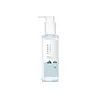What's inside
What's inside
 Key Ingredients
Key Ingredients

 Benefits
Benefits

 Concerns
Concerns

No concerns
 Ingredients Side-by-side
Ingredients Side-by-side

Water
Skin ConditioningDisodium Cocoamphodiacetate
CleansingCoco-Betaine
CleansingSodium Cocoyl Alaninate
Disodium Cocoyl Glutamate
CleansingSodium Chloride
MaskingGlycerin
HumectantAcrylates Copolymer
Decyl Glucoside
CleansingMacrocystis Pyrifera Extract
Skin ConditioningNasturtium Officinale Leaf Extract
MaskingSea Water
HumectantSodium Hyaluronate
HumectantHydroxypropyltrimonium Hyaluronate
Hydrolyzed Sodium Hyaluronate
Skin ConditioningHydrolyzed Hyaluronic Acid
HumectantSodium Acetylated Hyaluronate
HumectantHyaluronic Acid
HumectantSodium Hyaluronate Crosspolymer
HumectantPotassium Hyaluronate
Skin ConditioningHydrogenated Lecithin
EmulsifyingBetaine
HumectantAllantoin
Skin ConditioningTromethamine
BufferingPanthenol
Skin ConditioningHexylene Glycol
EmulsifyingDipropylene Glycol
HumectantBeta-Glucan
Skin ConditioningPotassium Benzoate
PreservativeFructooligosaccharides
Humectant1,2-Hexanediol
Skin ConditioningCitric Acid
BufferingDisodium EDTA
Water, Disodium Cocoamphodiacetate, Coco-Betaine, Sodium Cocoyl Alaninate, Disodium Cocoyl Glutamate, Sodium Chloride, Glycerin, Acrylates Copolymer, Decyl Glucoside, Macrocystis Pyrifera Extract, Nasturtium Officinale Leaf Extract, Sea Water, Sodium Hyaluronate, Hydroxypropyltrimonium Hyaluronate, Hydrolyzed Sodium Hyaluronate, Hydrolyzed Hyaluronic Acid, Sodium Acetylated Hyaluronate, Hyaluronic Acid, Sodium Hyaluronate Crosspolymer, Potassium Hyaluronate, Hydrogenated Lecithin, Betaine, Allantoin, Tromethamine, Panthenol, Hexylene Glycol, Dipropylene Glycol, Beta-Glucan, Potassium Benzoate, Fructooligosaccharides, 1,2-Hexanediol, Citric Acid, Disodium EDTA
Sodium Bicarbonate
AbrasiveSodium Lauroyl Glutamate
Sodium Cocoyl Isethionate
CleansingZea Mays Starch
AbsorbentCamellia Sinensis Leaf Powder
ExfoliatingLysine Hcl
Skin ConditioningProline
Skin ConditioningSodium Ascorbyl Phosphate
AntioxidantAcetyl Methionine
Skin ConditioningTheanine
EmollientCarica Papaya Fruit Extract
Skin ConditioningSorbitol
HumectantPapain
Skin ConditioningBetaine
HumectantCellulose Gum
Emulsion StabilisingCitric Acid
BufferingSodium Hyaluronate
HumectantSodium Bicarbonate, Sodium Lauroyl Glutamate, Sodium Cocoyl Isethionate, Zea Mays Starch, Camellia Sinensis Leaf Powder, Lysine Hcl, Proline, Sodium Ascorbyl Phosphate, Acetyl Methionine, Theanine, Carica Papaya Fruit Extract, Sorbitol, Papain, Betaine, Cellulose Gum, Citric Acid, Sodium Hyaluronate
 Reviews
Reviews

Alternatives
Ingredients Explained
These ingredients are found in both products.
Ingredients higher up in an ingredient list are typically present in a larger amount.
Betaine is a common humectant (a substance that promotes retention of moisture). It's known to be gentle on the skin and can help balance hydration.
This ingredient is best for improving hydration and soothing irritated skin. Studies also show it helps even out skin tone.
Fun fact: Betaine is naturally created in the skin and body. The kind found within cosmetic products can be either plant-derived or synthetic.
Another name for betaine is trimethylglycine.
Learn more about BetaineCitric Acid is an alpha hydroxy acid (AHA) naturally found in citrus fruits like oranges, lemons, and limes.
Like other AHAs, citric acid can exfoliate skin by breaking down the bonds that hold dead skin cells together. This helps reveal smoother and brighter skin underneath.
However, this exfoliating effect only happens at high concentrations (20%) which can be hard to find in cosmetic products.
Due to this, citric acid is usually included in small amounts as a pH adjuster. This helps keep products slightly more acidic and compatible with skin's natural pH.
In skincare formulas, citric acid can:
While it can provide some skin benefits, research shows lactic acid and glycolic acid are generally more effective and less irritating exfoliants.
Most citric acid used in skincare today is made by fermenting sugars (usually from molasses). This synthetic version is identical to the natural citrus form but easier to stabilize and use in formulations.
Read more about some other popular AHA's here:
Learn more about Citric AcidSodium Hyaluronate is hyaluronic acid's salt form. It is commonly derived from the sodium salt of hyaluronic acid.
Like hyaluronic acid, it is great at holding water and acts as a humectant. This makes it a great skin hydrating ingredient.
Sodium Hyaluronate is naturally occurring in our bodies and is mostly found in eye fluid and joints.
These are some other common types of Hyaluronic Acid:
Learn more about Sodium Hyaluronate